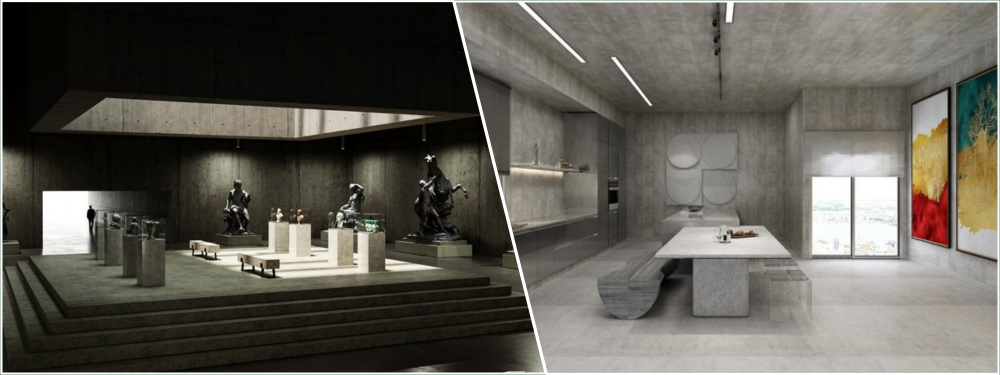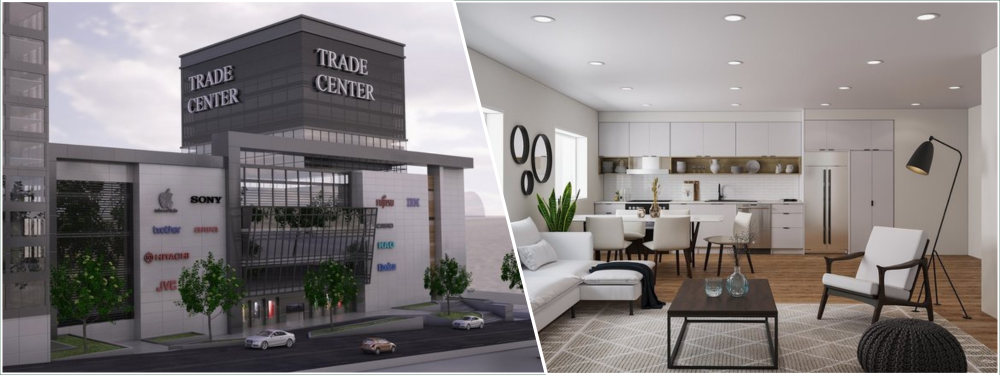Architectural rendering creates a photorealistic visualization of architectural objects using CGI software tools. The result is an almost entirely made-up image that exists only in a virtual environment. The process is quite similar to creating visual effects for films, but this time, the techniques are used for architectural projects. Modern computers with high processing powers can visualize just about anything imaginable.
Architects, engineers, designers, contractors, and homeowners utilize 3D architectural rendering services to inspect a project – and what it should look like when it is done – even before construction begins. Every part of a building can be created as a virtual object, including the exterior, interior, and the surrounding environment. When appropriately done by competent professionals, a render appears indistinguishable from photographs. The only difference is that rendering requires a physical object to exist in the first place.
 Table of contents
Table of contents
RELATED: Architectural 3D rendering styles and visualization techniques
Cost of architectural rendering
The skills and hardware requirements needed for quality architectural rendering are costly. Prices vary from $500 for a low-quality render to $3,000 for a no-compromise visualization.

Affordable option: $500 or Less
Architectural visualization services are like any other goods and services with which you get what you pay for. The affordable rendering option is at the bottom of the price range, costing at most $500 per image. But even though it is cheap, the results still need to find use. There are some situations where even a low-price render (and compromised quality as a consequence) makes a lot of sense, for example:
- Concept stage: There is no need to get all detailed and high resolution when the rendering is used only for the preliminary review process during the early conceptual phase. Think of the visualization as a virtual proof-of-concept meant to demonstrate essential design elements to clients. Since there are bound to be changes to the design, expensive visualization might be a big waste of resources.
- Small budget: When the project owner is clear about budget restrictions and efficiency is all that matters, high-quality architectural rendering is entirely optional. Detailed visualization is usually the first thing removed from the checklist if the client doesn’t want any unnecessary expense. Instead, pick affordable renders like simple floorplans or exterior snapshots (perhaps without texturing) and consider it done. Sometimes, even the 3D models alone are enough to please residential clients.
- Approval purpose: UHD architectural rendering is never a requirement to gain building permits and approvals from regulatory bodies. The blueprints or CAD drafts are more than enough for the purpose.
Some people prefer all the most excellent things, while others are more practical. If the construction project is personal, such as a minor DIY renovation or repair that does not require permits, sketches, and illustrations are ideal. When rendering is required, a simple visualization will do.
Other than for the purposes listed above, using low-quality architectural visualization may be considerably more expensive at the end of the day. You can cut corners and have the visualization done by an inexperienced freelancer. It is a gamble since the freelancers need more useful portfolios and clients’ feedback for your reference.
The only appealing thing in the offer is the low-price service and short turnaround time. Not every freelance rendering artist delivers poor-quality visualization, but it is wise to consider potentially expensive risks as follows:
- Additional fees for everything: Always read the fine print when making orders for architectural visualization. While it is valid for companies of all sizes and levels of experience, pay special attention to the contracts/agreements you sign with studios or firms of questionable track records. The low prices shown on their profiles and websites are likely for the early stages of the visualization process. Instead of showing the total cost for the final rendering (post-production result), the price might cover only 3D modeling services with lighting and shading. In other words, incomplete render. Another critical thing to verify is the final render resolution. Take advantage of the trick of low price that comes with a slight resolution limitation.
- Rush job: As stated in the initial quote, the short turnaround time requires a bit of scrutiny. A small room typically takes 2 – 3 days to render, while a residential house needs 5 – 8 days. You can help speed up the process by providing a finished 3D model, detailed project briefs, and reference photographs. If you make the order this morning, there is a good chance the project has to wait until the next several days before it gets to the actual rendering desk. The promise of an impossibly quick delivery time is a possible red flag. It might be a rush job for speedy completion without regard for quality.
- Expensive revision: Most reputable rendering studios and freelance rendering experts offer the first round of revision for free. The cost for fixing small mistakes and missing details (if any) is already included in the initial quoted price. A cheap render has every chance to come loaded with unrefined details that need improvement. Beware of anybody offering a low-price architectural visualization service because you may pay a lot more money to have it revised.
Budget is always an essential factor. Some render studios can afford to offer cheap visualization and cheat the process by recycling components from previous projects. Particular objects may look overoptimized, textures are mix-and-match, and the post-production process fails to remove imperfections. When buying architectural rendering, the significant rule of thumb is that if something seems too good to be true, it probably is.
Mid-range option: $500 – $3,000
The sweet spot in the architectural visualization market is between the cheapest and most expensive options. Most professional rendering studios fall within the category simply because they can cater to the most significant number of potential clients, from designers and contractors to developers and architects. Homeowners preparing for big renovation projects most likely opt for the mid-range option, too. It offers the best balance between price and quality, promising well-spent money.
Prices in the range are not overly expensive to the point where clients feel intimidated, but not too cheap that they bring the impression of low-quality either. You may need to move closer to the $3,000 mark to get the best bang for your buck, especially if the following factors are of the utmost importance:
- Creativity: architects and real estate developers need the best tools to convince clients and investors to spend their money. If lifelike visualization through photorealistic rendering services alone doesn’t make the idea stand out, a healthy dose of creativity is needed to highlight every unique design approach.
- Portfolio: Another effective tool to attract potential customers is an impressive portfolio. Architects, engineers, contractors, and subcontractors can use architectural renderings to showcase their previous works. Each image becomes a testament to their expertise and experience in the industry. Designers may display interior renderings, landscape design experts or architects post their public park projects, and contractors highlight their most recent residential pools. Just about every professional in the architectural industry should utilize quality rendering to build a respectable portfolio. Make sure all visualizations in the portfolio come with verifiable claims and references.
- Winning construction bid: Contractors who engage in a construction bidding process have a bigger chance of securing the project using photorealistic renderings. Affordable renderings might be a viable cost-saving option to avoid financial loss. Still, a quality visualization improves the events of the architect (or project owner) taking serious notice of the bid.
Because most rendering firms and independent freelancers offer mid-range options, it can take a lot of work to pick one that best suits your needs. Make the time and effort to do your homework by comparing prices, turnaround time, portfolios, reputations, and feedback from previous clients. Communication also matters because you want to discuss the project before ordering. Prompt answers to your inquiries and willingness to ask for additional details are promising signs of a professional freelance 3D render artist.

RELATED: Top 6 architectural visualization and 3D rendering trends for your company to follow
Top range: $3,000 or more
Architectural visualization that costs $3,000 or more is often preserved for top-rank professionals when working on large-scale commercial projects. Using renderings that cost thousands of dollars per piece makes little sense if the entire project is worth anything less than six figures.
A big architectural project involving many stakeholders requires more than one top-quality rendering. The architects may have to present dozens of visualizations to contextualize the designs and demonstrate cost-quality balance.
At $3,000 or more, you should be able to hire a reputable rendering studio with a proven track record to get the job done. If you are willing to pay a little higher, the studio might also be ready to expedite the process.
Price per image
Bear in mind that each price above is for one still visualization image. For 3D architectural animation and visualization services, standard quality costs range from $5,000 to $10,000. The price can go up depending on length, complexity, and resolution.
How Cad Crowd can assist
Don’t leave your architectural projects to chance; ensure you understand the costs, rates, and pricing involved in architectural rendering. Ready to take your projects to the next level? Contact Cad Crowd today for a free quote.
Our expert architectural rendering professionals are here to help you achieve your vision within your budget. It’s time to elevate your designs and make your projects stand out. Click here to learn how it works, and start your journey to remarkable architectural rendering today.

1 comment